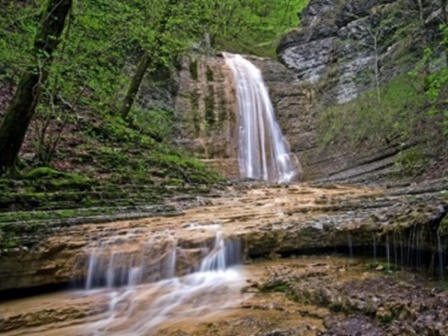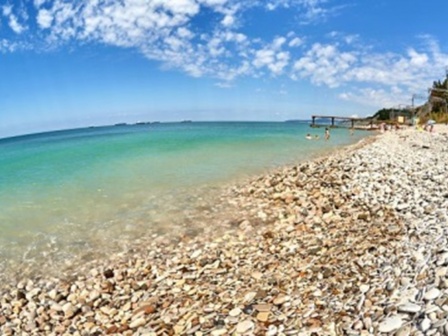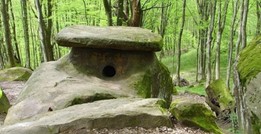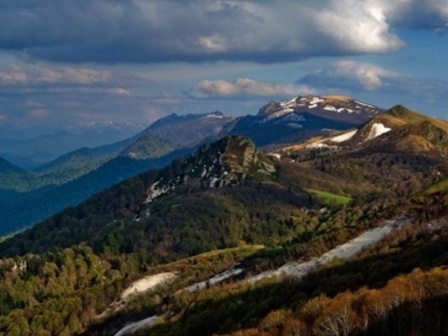Resource base
Climate
- The average monthly temperature during the hottest months of July and August ranges from +24 to +25 °C (75–77 °F), while during the coldest months of January and February, it ranges from +4 to +5 °C (39–40 °F).
- The average yearly precipitation ranges from 1,000 to 1,400 mm.
- Throughout the year, the prevailing winds come from the southeast.
- From May to September, the weather conditions are considered comfortable. This climate is ideal for both winemaking and agriculture.
Mineral
resources
Fresh water
reserves
- There are 13 water intake structures in the Tuapse district.
- During the summer dry season, water supply interruptions occur due to reduced rainfall, increased water usage from holidaymakers, and high daily water consumption in certain settlements, both organized and unorganized.
- As of now, the water supply at the water intake facilities is abundant, including at the water intake in the village of Georgievskoye until the end of 2025.
Fertile
lands
- perennial plantations cover about 650 hectares, including stone and seed trees
Recreational resources
- The Main Caucasus Range’s altitude within the municipality rises from 700 m to 1,634 m from northwest to southeast.
- The municipality’s appeal comes from its varied landscape, blending gentle slopes with rugged Alpine terrain. Along the coast, the presence of sea terraces with nearly flat surfaces makes it ideal for building resorts.
- Three large rivers, Shapsukho at 45 km long, Nechepsukho at 26 km, and Tuapse at 35 km, originate from the main Caucasus ridge and flow southwest.
- In the lower part, there are wide valleys, up to 2 km in width. In the upper part, there are numerous smaller rivers and streams, along with very attractive canyons and waterfalls.

Waterfalls
Waterfalls are a fascinating natural phenomenon, abundant in the Tuapse district, including near the city of Tuapse. These waterfalls are popular stops on many tourist routes. You don’t have to trek long distances through mountainous terrain to witness these wonders, like the 33-meter Perun waterfall near the village of Krasnoye. Some waterfalls, like the Polkovnichi and Tenginskie waterfalls, require navigating challenging mountain paths, but this doesn’t stop nature lovers. From spring onwards, tourists come to these paths, discovering the diverse nature of the southern district with each step. The area boasts liana-like plants, shrubs, ancient towering trees, mosses, and streams with chilly water, creating a unique and enriching experience for every visitor.

Beaches
One of the most appealing features of recreation in the Tuapse district is its beautiful beach areas, known for their scenic locations and well-developed facilities.
The coastal area of Tuapse district spans approximately 90 km. There are 75 beaches in the area, 11 of them are municipal.
Most of the beaches in Tuapse district are covered with a mix of large and small pebbles, along with some coquina and quartz sand. The presence of pebbles is beneficial as it helps keep the water near the shore clear throughout the day, even when there are many people around.
Another benefit of having pebble coating is the free daily therapeutic foot massage it provides. Pebble beaches stretch from the settlements of Shepsie and Dederkoi in the east of the district to Novomikhailovskoye, where the pebble-sand and sandy beach areas start.

Dolmens
Tuapse district is rich in megalithic monuments known as dolmens, which are remnants of an ancient civilization. There is ongoing debate among scientists regarding the intended purpose of these stone structures, which were constructed over two thousand years ago by the ancient tribes residing in this region.
The most common type of dolmen can be found in the village of Prigorodnoye. The Prigorodny Dolmen on Bogatyrka Mountain is one of the largest in Krasnodar region. The path to these ancient structures is named “Dolmens: the Road to Happiness.” Over the years, locals have believed in the mystical abilities of dolmens, claiming that touching these impressive structures can make wishes come true. Dolmens are regarded as the most enigmatic and least explored ancient monuments.

Mountains
Mountains in the Tuapse district are popular for active tourism.
The route is accessible year-round due to the warm climate in our district.
Semiglavaya Mountain is among the most stunning peaks in the Tuapse district, standing at a height of 1,453 meters. The closest settlement is Bolshoye Pseushkho, typically serving as the starting point for the ascent to the mountain peak. Tourist like this mountain because of its vast landscapes, meadows, and, of course, its breathtaking mountain panoramas.
Mount Indyuk (Turkey) is the most renowned mountain in the Tuapse district, standing at 859 meters tall. Its fame extends beyond Krasnodar region due to its stunning rocky formations. The journey begins at the village of Indyuk, with a 4 km walk taking approximately 3 hours round trip.
Mount Semashkho is situated in the northeast of Tuapse city, reaching a height of 1,035 meters above sea level. In 1982, a memorial complex called “Fortitude of Komsomol” was built at its summit. This vantage point offers stunning views of the peaks of the Main Caucasus Range, the sea, and the city of Tuapse.



